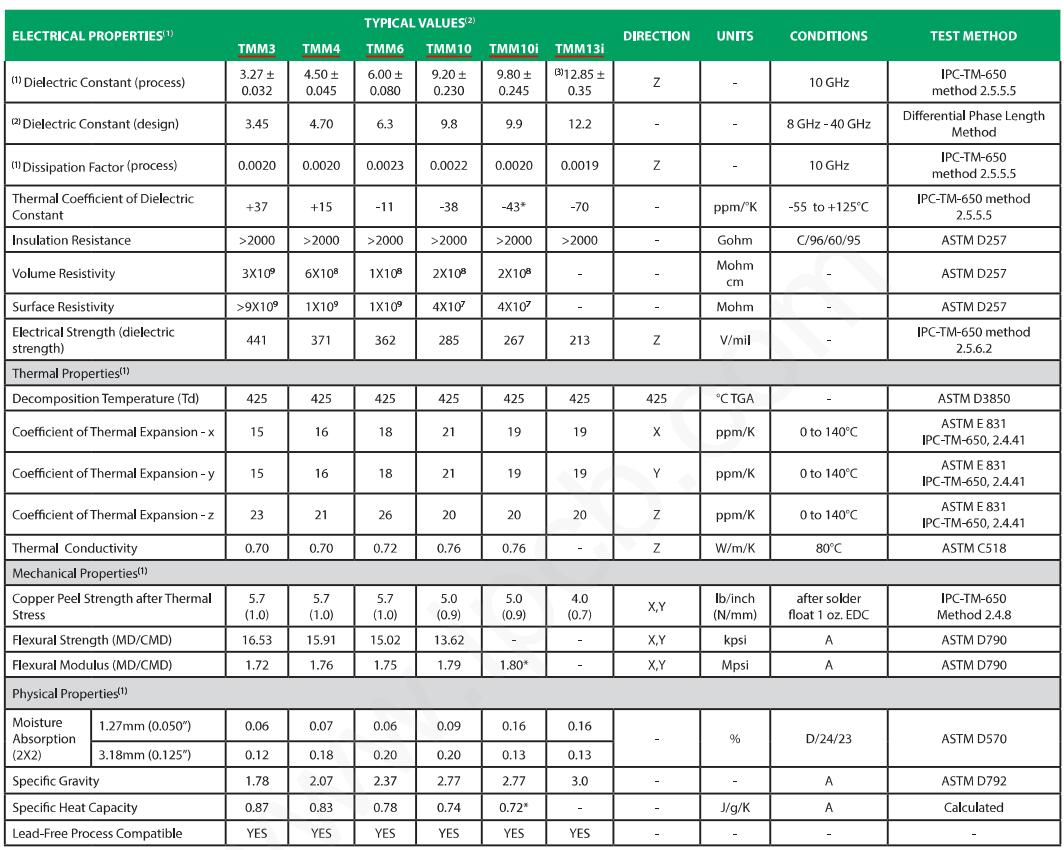Rogers TMM thermosetting microwave PCB materials combines low dielectric constant thermal change rate, thermal expansion coefficient consistent with copper foil and consistent dielectric constant. Because of their stable electrical and mechanical properties, TMM high-frequency PCB materials are ideal for high-reliability stripline and microstrip applications. Compared with alumina filler substrates, TMM laminates have obvious processing advantages. It can provide larger specifications of copper clad and use standard PCB substrate processing procedures.
TMM can provide dielectric constants from 3 to 13, and thicknesses from 0.015 to 0.500 to choose from, while maintaining a tolerance of plus or minus 0.0015 inches.
TMM 13i Hydrocarbon Ceramic Isotropic Thermosetting Microwave Material is a ceramic filled thermosetting polymer, specially designed for stripline and microstrip line applications that require high through-hole reliability. TMM 13i hydrocarbon ceramics have a dielectric constant of 12.85 (+/- 0.350) and are available in thicknesses from 0.015 to 0.500 (+/- .0015 inches).
Advantages of TMM series thermosetting microwave laminate:
Rich candidate dielectric constant, Excellent mechanical properties, resistance to creep flow and cold flow, Rare very low rate of change of dielectric constant with temperature, Fit the thermal expansion coefficient of copper foil to ensure the reliability of plated through holes, Resistant to chemical reagents, there is no damage in the production and placement process, Thermosetting resin ensures reliable wire bonding, No special processing technology is required, TMM10 and 10i laminates can replace alumina substrates, Passed RoHS certification, environmentally friendly
Typical application of TMM 13i thermosetting microwave laminate
RF and microwave circuits, GPS antenna, Power amplifier and combiner, Microstrip antenna, Filters and couplers, Dielectric polarizer and lens, Chip testing


Rogers Thermoset Microwave PCB Materials(TMM3, TMM4, TMM6, TMM10, TMM10i, TMM13i)
TMM thermosetting microwave materials are ceramic, hydrocarbon, and thermosetting polymer composite materials, designed for high reliability stripline and microstrip line applications with electroplated through-holes. TMM laminates can be used for a wide range of dielectric constants and cladding.
The electrical and mechanical properties of TMM laminates combine many of the advantages of ceramic laminates and traditional PTFE microwave circuit laminates without the need for the professional production technology shared by these materials. TMM laminates do not need to be treated with sodium naphthoate before electroless plating.
TMM laminates have a very low dielectric constant thermal coefficient, usually less than 30 ppm/°C. The isotropic coefficient of thermal expansion of the material closely matches that of copper, allowing the production of highly reliable plated through holes and low etch shrinkage values. In addition, the thermal conductivity of TMM laminates is about twice that of traditional PTFE/ceramic laminates, which is good for heat dissipation.
TMM laminates are based on thermosetting resins and will not soften when heated.
Therefore, the wire bonding of the component leads to the circuit traces can be performed without considering pad lifting or substrate deformation.
TMM laminates combine many of the ideal characteristics of ceramic substrates with the ease of use of soft substrate processing technology. TMM laminates can be used 1/2 oz/ft2 to 2 oz/ft2 of electrodeposited copper foil, or directly bonded to brass or aluminum plates. The substrate thickness is 0.015" to 0.500". The substrate has corrosion resistance to corrosive agents and solvents used in the production of printed circuits. Therefore, all commonly used PWB processes can be used to prepare TMM thermoset microwave materials.
The antenna and antenna feed system on the space-borne equipment were originally designed with structural parts, but they are large in size and heavy, and now I hope to use microwave panels to make them. However, considering that it works in outer space, where the air is thin, the air pressure is low, and the temperature varies greatly between -55 degree Celsius and +150 degree Celsius, I have been hesitating how to choose suitable antenna and feeder PCB materials.
At present, according to the overall size of the antenna, the approximate electrical characteristics are required to be a dielectric constant of about 3.5, a total thickness of about 120 mils, and a double panel.
Rogers TMM series thermosetting microwave laminates are ceramic-filled thermosetting high molecular polymers, which are especially suitable for use on satellites. It can provide a dielectric constant from 3 to 13, and a thickness of 0.015 to 0.500 to choose from, while maintaining a tolerance of ±0.0015 inches. TMM 3 hydrocarbon ceramic is one of the TMM series of microwave PCB. Its design dielectric constant is 3.45, which is very close to 3.5. It can provide the thickness as shown in Table 1 below. It can be directly selected to a thickness of 125 mil, without the need for multiple layers. The method of pressing and summing to achieve the required thickness.
In addition, when used in space-borne outer space, the temperature change of the dielectric constant of the TMM3 microwave sheet is small, with a change of +37ppm/K in the range of -55 degree Celsius~+150 degree Celsius, which can guarantee the performance of the antenna. . The X/Y/Z CTE is 15/15/23, which is consistent with the thermal expansion coefficient of the copper foil, ensuring the stability and reliability of the microstrip line/strip line performance.